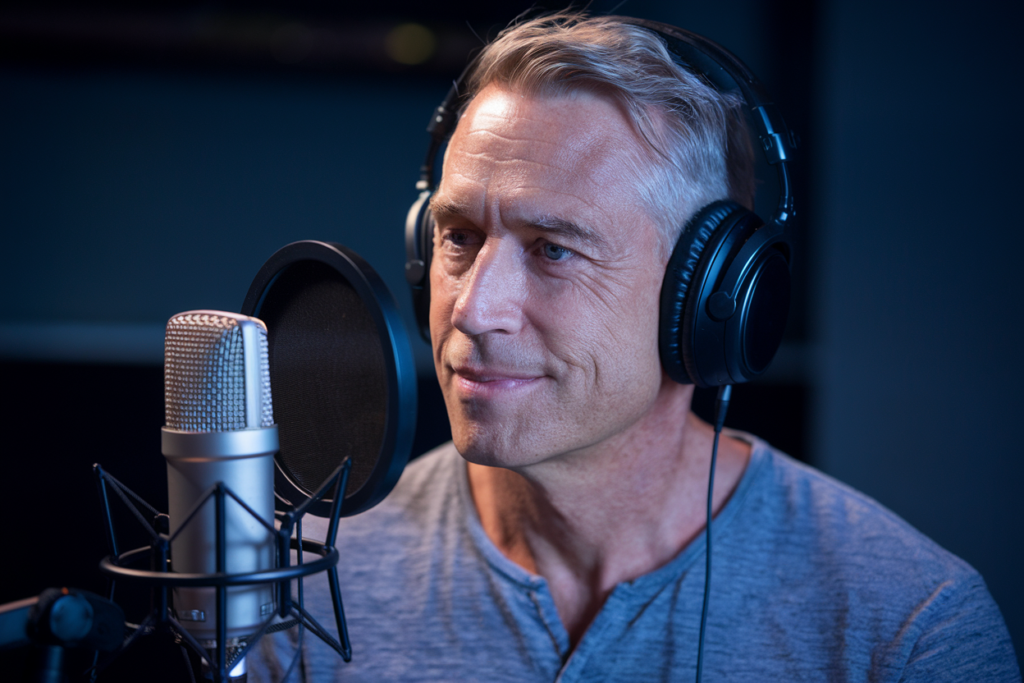Directing American English voice actors is a unique art that blends creativity with technical skill. Whether you’re working on animations, video games, or commercials, understanding how to guide talent effectively can make all the difference in your project’s success. The nuances of voice direction can elevate performances and resonate deeply with audiences.
In this dynamic field, you’ll discover that clear communication and an encouraging atmosphere are key to unlocking each actor’s potential. With the right techniques and insights, you can foster authentic performances that bring characters to life. Let’s explore essential strategies for directing voice actors and ensure your vision translates seamlessly into sound.
Key Takeaways
- Understanding the Art of Voice Acting: Successful voice acting requires emotional nuance, character development, and script interpretation, tailored to various genres like animation and commercials.
- Director’s Role: The director is essential in guiding performances through effective communication, casting suitable voice actors, and providing constructive feedback during sessions.
- Casting Techniques: Selecting the right voice talent involves thorough research on character fit, genre suitability, and the experience level of potential candidates.
- Directing Strategies: Employ techniques such as clear coaching, creating a supportive environment for experimentation, and utilizing relevant audition scenes to enhance performance quality.
- Common Challenges: Directors face issues such as performance inconsistency and technical difficulties; addressing these with clear communication and a comfortable atmosphere can lead to better outcomes.
- Promoting Authenticity: Establishing rapport with voice actors encourages genuine performances that resonate with audiences across different media platforms.
Understanding Voice Acting
Voice acting involves the performance of voice actors who portray characters or convey messages through their vocal skills. It requires not only a good voice but also an understanding of emotional nuance, character development, and script interpretation.
Voice actors bring scripts to life by utilizing their unique vocal qualities and styles. They must adapt to various genres, including animation, video games, commercials, and narration. Each genre demands different approaches; for instance, animated characters often require exaggerated expressions while commercial voiceovers focus on clarity and persuasion.
Directing voice talent effectively hinges on clear communication. Providing specific feedback helps voice artists understand the desired tone or emotion for a scene. Creating a supportive environment encourages experimentation, allowing actors to explore multiple interpretations of their roles.
Understanding the technical aspects of recording is also vital. Familiarity with sound equipment and recording techniques can streamline sessions with voice over talent. This knowledge allows you to address any issues quickly and maintain productivity during recordings.
Incorporating these elements into your directing process leads to authentic performances from your voice actors that resonate with audiences across various platforms.
The Role of the Director
The director plays a crucial role in guiding voice actors to deliver compelling performances that align with the project’s vision. Through effective communication and support, you help voice talent tap into their emotional range and character depth.
Key Responsibilities
- Casting: Selecting the right voice actor for each character based on vocal quality and suitability.
- Session Management: Overseeing recording sessions to ensure smooth operation and adherence to schedules.
- Feedback Provision: Offering constructive feedback during recordings, allowing voice artists to adjust their performances as needed.
- Creative Guidance: Collaborating with writers and producers to interpret scripts accurately while maintaining artistic integrity.
- Performance Direction: Encouraging experimentation with different tones, pacing, and styles to discover unique interpretations.
- Communication Skills: Clearly articulating your vision fosters strong collaboration between you and the voice actor.
- Technical Knowledge: Understanding sound equipment and recording techniques ensures efficient session management.
- Empathy: Building rapport with voice talent creates a supportive environment where they feel comfortable exploring their craft.
- Adaptability: Adjusting direction based on the specific needs of various genres enhances performance authenticity.
- Critical Listening: Evaluating performances critically helps refine delivery while staying true to project objectives.
Casting American English Voice Actors
Casting voice talents for projects involves a strategic approach to ensure your vision connects with the right performers. Selecting the appropriate voice actor can enhance character authenticity and elevate your project’s impact.
Finding the Right Talents
Finding suitable voice actors requires thorough research and an understanding of your project’s needs. Consider these factors:
- Character Fit: Identify how each voice artist’s tone, pitch, and style align with the characters in your script.
- Genre Suitability: Different genres demand unique vocal qualities; animations may require more exaggerated expressions, while commercials often call for clarity and professionalism.
- Experience Level: Evaluate the background of potential voice over talents. Experienced artists might bring valuable insights into performance nuances that less experienced ones may overlook.
Utilizing casting platforms or auditions allows you to assess various candidates effectively. Listen closely for emotional delivery, versatility, and uniqueness in their performances.
Audition Techniques
Implementing effective audition techniques streamlines the selection process for voice actors. Here are key methods to consider:
- Provide Clear Direction: Offer specific guidance on tone, pacing, and emotion during auditions to help talent understand your expectations.
- Use Relevant Scenes: Select excerpts from scripts that highlight essential aspects of characters or situations they’ll portray. This practice showcases how well they adapt their performances.
- Encourage Experimentation: Allow room for creativity by encouraging actors to explore different interpretations of their lines. This fosters a relaxed environment where genuine performances emerge.
Review recordings critically after auditions to select those who resonate most with your project’s goals. Prioritizing strong communication throughout this process ensures you choose talented individuals who can bring depth and character authenticity to your production.
Directing Techniques for Voice Actors
Directing voice actors involves specific techniques that enhance performance and ensure clarity in conveying the project’s vision. Effective communication, constructive feedback, and a supportive atmosphere play crucial roles in this process.
Coaching and Feedback
Coaching voice actors requires a blend of guidance and encouragement. Provide clear direction regarding character emotions, pacing, and delivery styles tailored to the script’s needs. Offer constructive feedback that highlights strengths while addressing areas for improvement. Use phrases like “try emphasizing this line” or “let’s explore a different tone” to encourage exploration without discouraging creativity. Regularly check in with the voice talent to gauge their comfort levels and understanding of your expectations, fostering an open dialogue that promotes growth.
Creating the Right Environment
Creating an optimal recording environment significantly impacts voice performances. Ensure the space is free from distractions and equipped with high-quality soundproofing to capture accurate vocal nuances. Encourage relaxation by allowing breaks between takes, as tension can hinder natural delivery. Establish a collaborative atmosphere where voice artists feel valued; this includes celebrating successful takes while gently guiding them through challenges. When actors feel secure in their surroundings, they’re more likely to deliver authentic performances that resonate with audiences across various platforms.
Challenges in Directing Voice Actors
Directing voice actors presents unique challenges that can impact the overall quality of a project. Understanding these issues allows you to create more effective strategies for achieving desired results.
Common Issues
- Performance Inconsistency: Voice actors may deliver varied performances during different takes, leading to challenges in maintaining consistency across scenes.
- Emotional Range Limitations: Some voice talents struggle with conveying complex emotions, which can hinder character development and authenticity.
- Technical Difficulties: Recording sessions may encounter technical problems such as poor sound quality or equipment malfunctions, disrupting the flow of work.
- Miscommunication: Vague direction can lead to misunderstandings about character portrayal, pacing, or tone, resulting in unsatisfactory performances.
- Nervousness or Anxiety: Voice actors may experience performance anxiety that affects their ability to deliver compelling readings.
- Establish Clear Communication: Provide specific feedback on each performance aspect, including emotional depth and pacing. Use examples from the script to clarify expectations.
- Create a Comfortable Environment: Cultivate a supportive atmosphere where voice artists feel relaxed and encouraged to experiment without fear of judgment.
- Utilize Technical Tools Effectively: Familiarize yourself with recording equipment and software settings to minimize technical issues during sessions.
- Encourage Breaks for Relaxation: Incorporate short breaks into long recording sessions to help reduce tension and refresh focus among voice talents.
- Conduct Rehearsals Before Recording: Allow time for rehearsals so voice actors can explore their characters fully before committing to final takes.
By recognizing common challenges and implementing best practices, you enhance your ability to direct voice actors successfully, leading to authentic performances that resonate with audiences across various platforms.
Conclusion
Directing American English voice actors is an intricate blend of art and skill. By fostering a supportive atmosphere and maintaining clear communication, you can unlock the full potential of your talent. Emphasizing emotional depth and character nuances allows for performances that truly resonate.
It’s crucial to balance feedback with encouragement while adapting your approach based on the genre at hand. Recognizing challenges along the way will enable you to implement effective strategies that enhance performance quality. Ultimately, your role as a director shapes not just the sound but the entire experience for audiences.
Frequently Asked Questions
What is the main focus of the article on directing voice actors?
The article focuses on the blend of creativity and technical skill needed to direct American English voice actors effectively. It emphasizes clear communication and a supportive environment to help actors deliver authentic performances in various projects like animations, video games, and commercials.
Why is communication important in directing voice actors?
Clear communication is crucial as it helps directors convey their vision to voice actors. By providing specific feedback and guidance, directors can ensure that performers understand character emotions and delivery styles, leading to more authentic performances.
What are some key responsibilities of a director when working with voice actors?
Directors are responsible for casting suitable talent, managing recording sessions, providing constructive feedback, and collaborating closely with writers and producers. These roles require strong communication skills, empathy, adaptability, and critical listening abilities.
How do genre differences affect voice acting direction?
Different genres demand distinct approaches; for example, animation may require exaggerated expressions while commercial work needs clarity. Effective direction involves understanding these nuances to guide performances that fit each genre appropriately.
What techniques can enhance voice actor performances during recording sessions?
Techniques include offering clear guidance on character emotions and pacing while fostering a supportive atmosphere for exploration through positive feedback. Creating an optimal recording environment also helps capture vocal nuances effectively.
What challenges do directors face when working with voice actors?
Common challenges include performance inconsistency, emotional range limitations, technical difficulties, miscommunication, and performance anxiety. Directors can overcome these issues by establishing clear communication and creating a comfortable environment for performers.
How does casting impact the overall project involving voice acting?
Casting the right talent significantly enhances character authenticity and elevates the project’s impact. Factors such as character fit and genre suitability must be considered carefully during auditions to find suitable performers who align with project goals.
Why is a supportive atmosphere important in directing voice actors?
A supportive atmosphere encourages experimentation among performers while reducing tension during recording sessions. This comfort allows voice actors to explore their emotional range more freely, resulting in richer performances that resonate with audiences.







